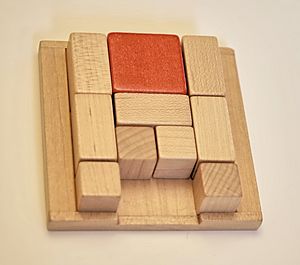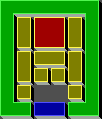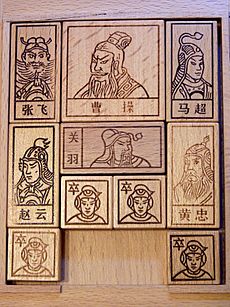Klotski facts for kids
Klotski is a fun sliding block puzzle. It's like a game where you move wooden blocks around in a box. The name Klotski comes from the Polish word klocki, which means "wooden blocks." People think this puzzle first appeared in the early 1900s.
Sometimes, Klotski refers to a specific puzzle with ten blocks. Other times, it means any sliding block puzzle where you need to move one special block to a certain spot.
Contents
How to Play Klotski
Just like other sliding block puzzles, Klotski has different-sized blocks inside a box. The box is usually a 4x5 grid.
Among all the blocks, there's one special block. It's usually the biggest one. Your goal is to move this special block to a certain area on the game board. You can't take any blocks out of the box. You can only slide them up, down, left, or right. Players often try to solve the puzzle using the fewest moves or in the shortest time.
Where Did the Name Klotski Come From?
The name Klotski first appeared in 1991. It was used for a computer game version for Windows 3.x. This game was even part of the Microsoft Windows Entertainment Pack.
Before this, the puzzle was sold under many different names. Some of these names were Psychoteaze, Square Root, Intreeg, and Ego Buster. There wasn't one common name for this type of sliding puzzle until Klotski came along.
Solving the Puzzle
For the original Klotski puzzle, the fewest number of moves needed to solve it is 81. Computers have checked this, and it's the absolute minimum if you count each slide of a block as one move.
The first time an 81-step solution was published was in 1964. It was in a magazine called Scientific American, written by Martin Gardner. An earlier solution, though not the shortest, was published in a Chinese book in 1952. It showed a way to solve the puzzle in 100 steps.
Different Versions of Klotski
There are many different versions of the Klotski game. Some have names that are special to certain countries. Others have the blocks arranged in different ways. We don't know for sure how these different versions influenced each other.
Other Names for Klotski
Some versions of Klotski have the exact same block setup. Only their names are different, often with a story behind them. It's very likely they all came from the same original puzzle.
Huarong Dao
Huarong Dao is the Chinese version of Klotski. Its name comes from a famous Chinese story. It's about a warlord named Cao Cao who was escaping after a big battle. He had to go through a place called Huarong Trail.
An enemy general, Guan Yu, was waiting for him there. But Guan Yu had been treated well by Cao Cao in the past. So, Guan Yu let Cao Cao pass. In the game, the largest block is named "Cao Cao."
Daughter in the Box
The Daughter in the Box is a Japanese wooden puzzle. Its Japanese name is hakoiri musume (箱入り娘). The story is about an "innocent young girl" who is stuck in a building. The largest piece in this game is called "daughter." Other blocks are named after family members, like "father" and "mother."
There's another Japanese version that uses the names of shogi (Japanese chess) pieces.
L'âne rouge
In France, this puzzle is known as L'âne rouge, which means "The Red Donkey." In this version, the largest piece is a red donkey. It's trying to escape from a maze of fences and pens to reach its carrots. We don't know when this version first appeared in France.
Khun Chang Khun Phaen
This version comes from Thailand. It's named after a famous Thai story called Khun Chang Khun Phaen. In the story, a character named Khun Phaen is in prison. The game shows Khun Phaen breaking out of prison by getting past nine guards.
This version is a little different from the standard Klotski. Two small 1x1 blocks are moved to the bottom. But all the other blocks are the same. We don't know where this Thai version came from.
Klotski with Different Block Setups
The "basic" Klotski game usually has a 4x5 area. The blocks are arranged in a specific way:
- Two tall 1x2 blocks and a small 1x1 block are on the left side.
- Two tall 1x2 blocks and a small 1x1 block are on the right side.
- In the middle, there's a large 2x2 block at the top. Below it is a wide 2x1 block. Then two small 1x1 blocks. This leaves an empty 2x1 space at the bottom.
This is the most common setup for Klotski around the world.
Pennant Puzzle
The Pennant Puzzle is a different version. It was first copyrighted in 1909 in the United States. Later, in 1926, it was copyrighted again as Dad's Puzzler.
Here's how it's different:
- The blocks start in different places. For example, the largest square block is in the top left corner.
- It's also a 4x5 area, but it has one 2x2 block, two 1x2 blocks, four 2x1 blocks, and two 1x1 pieces.
- The special block doesn't exit from the bottom middle. Instead, it exits from the bottom left.
Even with these differences, the rules are the same as Klotski. You need at least 59 moves to solve this puzzle.
Ma's Puzzle
Ma's Puzzle was copyrighted in 1927. It was special because it was the first sliding puzzle to use blocks that were not just rectangles. Its goal is to put two L-shaped pieces together, either anywhere on the board or in the top right corner.
Klotski on Computers
One of the first computer versions with graphics was made in 1988. Then, in 1991, Klotski became famous when it was included in the third Microsoft Windows Entertainment Pack. After that, many other computer versions of Klotski were made, some free and some for sale. For example, you can find a Klotski game in the GNOME desktop environment. Some computer versions even have blocks with special effects!
Images for kids
See also
 In Spanish: Klotski para niños
In Spanish: Klotski para niños







